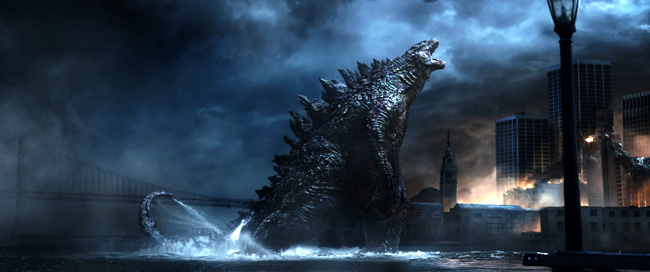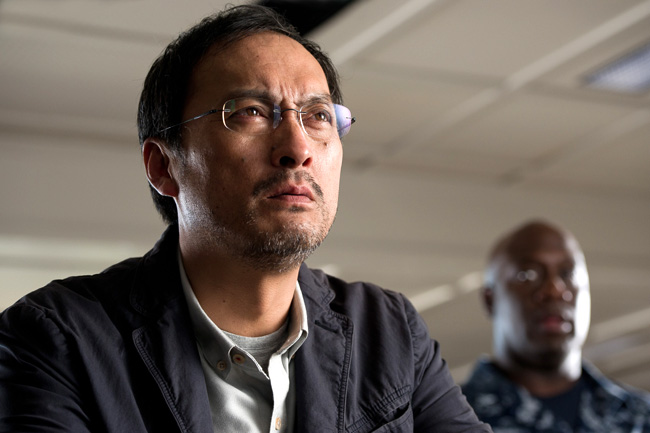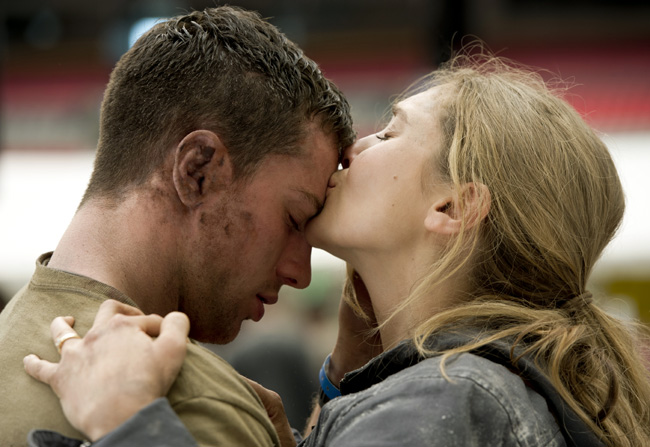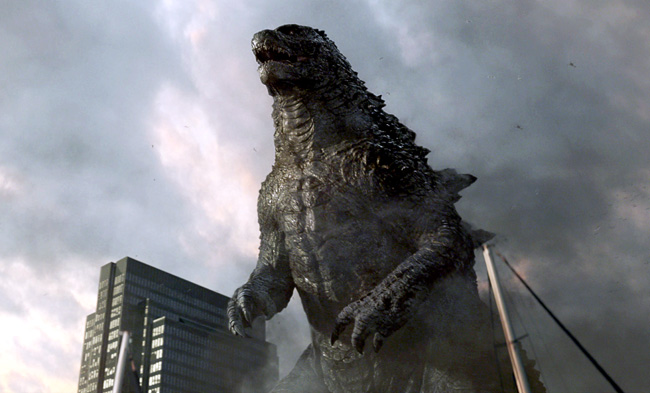CHICAGO – Patrick McDonald of HollywoodChicago.com appears on “The Morning Mess” with Dan Baker on WBGR-FM (Monroe, Wisconsin) on March 21st, 2024, reviewing the new streaming series “Manhunt” – based on the bestseller by James L. Swanson – currently streaming on Apple TV+.
Hollywood’s ‘Godzilla’ Misses, Mocks Ishirô Honda’s Main Warning Message
 Rating: 2.5/5.0 |
CHICAGO – Except for the clear purpose of cashing in on yet another “Godzilla” remake, everything is happening for no reason. Worst of all, what is ensuing misses and even mocks the reason why Ishirô Honda originated 1954’s “Godzilla” in the first place.
Since then, times have dramatically changed and blockbuster Hollywood movies have a new boss to answer to: the box office. Still, we can’t forgive a film that focuses on CGI and big-city destruction while assuming we don’t care about a story and the honesty of where that plot needs to have its roots. The original “Godzilla” is an understandable outpouring from Japan when it was suffering in real life. America isn’t traumatized here.

Photo credit: Warner Bros. Pictures
It’s insulting to audiences to think the eye-candy fed to the two holes above our nose is more important than the brain that sits atop our head. Our minds have to be equally satisfied. Whether or not you’re a longtime “Godzilla” purist who wants each incarnation to have some of its original authenticity, it’s just too easy to fault Gareth Edwards’ 2014 version for what this film isn’t.
“Godzilla” is a “kaiju” (a “strange creature” in Japanese) that refers to a genre of “tokusatsu” entertainment (Japanese special effects). Ishirô Honda’s intention was to signal a loud warning about the dangers of nuclear bomb testing at the Bikini Islands in 1954. His response was his 1954 “Godzilla” film, which was designed to shed light on the dangers of atomic warfare so they’d be convinced to cease production.
Edwards’ 2014 version of “Godzilla” – from Warner Bros. Pictures and Legendary Pictures (which brought us “The Dark Knight”) – is the 30th Godzilla movie made. Towering over large skyscrapers, Godzilla is unsurprisingly even bigger than we’ve seen him before. A previous American version was made in 1998 by TriStar Pictures starring Matthew Broderick from director Roland Emmerich.
But before these two American films, Japan has been all about Godzilla – having released an incredible 28 Godzilla films all produced by one Japanese studio: Toho Studios.

Photo credit: Kimberley French, Warner Bros. Pictures
Interestingly, Godzilla is to Japan very much like James Bond is to the United Kingdom. With nearly the same amount of movies and originating around the same time period from a single studio, there have been 25 James Bond films since 1953. Only two of them weren’t made by Eon Productions.
Now while Godzilla has unquestionably succeeded as a global franchise phenomenon from a financial perspective, much of what we’ve seen since Honda’s 1954 film has been a large departure from the creature’s roots. As the primary Japanese actor in the 2014 American film, Ken Watanabe as Dr. Ichiro Serizawa is the only one who remembers Honda’s original spirit and warns against using nuclear weapons. Aside from Watanabe, our Hollywood stars in this film are forgettable.
But even Watanabe’s fears are overlooked by a film whose primary mission is to pit huge monsters against each other with a weak understanding of why they’re fighting. Sure, Godzilla and the M.U.T.O.s have hated each other for a long time and now must fight it out. It’s like two parents who have bottled-up angst and they’re getting divorced to create theatrical drama instead of going to therapy to work it out.
In the end, the primary reason is to show off Hollywood’s CGI advances. Yes, Godzilla looks amazing, but that’s not enough any more. Lacking substance and truth from its origins, this “Godzilla” feels very “Transformers” and Michael Bay-esque with its addiction to being big, loud and expensive.
Understandably, 2014’s version doesn’t have to be 1954’s original and it’s not trying to be. The fear that was nuclear then has transformed into a different one now: climate change. But while being something new, it still must be able to stand by itself with its own plot progression, consistent pacing, enemies who serve a purpose and heroes you want to root for. Even if you throw away all 29 previous films and pretend this one debuted Godzilla to the world for the very first time, Gareth Edwards’ film has gaping and unforgivable holes.

Photo credit: Kimberley French, Warner Bros. Pictures
While understandably needing it these days, Godzilla isn’t and shouldn’t be about CGI. Without a cohesive story that’s based in the originator’s roots, we’re left with an inauthentic film that only has a few crowd-pleasing, Godzilla-killing moments. And even Godzilla’s own screen time is shockingly sparse. Godzilla is supposed to be our hero. If we are going to primarily brush aside the nuclear fear, at least we could go to an emotional place like getting to know Godzilla himself.
We do in very brief moments. I want to understand him, but we just scratch the surface of starting to feel his loneliness. We need more from inside his huge head and his intentions to truly get behind him as our savior. All the “restoring nature’s balance” dialogue is filler to excuse the fact that he’s really just awakened to ward off whatever monstrous enemy of the day decides to attack humanity.
In this case, we have a boy and a girl M.U.T.O. – dragon-like monsters – who don’t have a well-explained qualm with Godzilla. All the while, humans are but pointless ants in the mix who have no choice but to watch the ensuing destruction. All the bullets and missiles and fighter jets and tanks we throw at these creatures bounce off them like throwing cotton balls at a grown man.

Photo credit: Warner Bros. Pictures
Godzilla’s enemies even mock Honda. Instead of warning against nuclear weapons, the M.U.T.O.s decide the bombs are tasty and they enjoy eating them for dinner. Now on an interesting tangent, they bring back a concept we remember in 2001’s “Ocean’s Eleven”: the EMP. Then a non-nuclear Electromagnetic Pulse, that EMP was placed in a van to shut down the electrical power to Las Vegas so they can rob a casino without security.
The M.U.T.O.s have the same power, but for dramatic effect, they randomly decide to kill electricity so fighter jets fall out of the sky, trains stop, mobile phones shut off and radar goes dark. But why? These Massive Unidentified Terrestrial Organisms – one is ground based and one is airborne – aren’t threatened by people. Clearly the only reason they’re EMPing us is for special effect.
The film reveals its true purpose – which ultimately is its lack thereof – when Watanabe says we should just sit back, do nothing and let the monsters fight each other. Our government, of course, can’t do that and must attack for national security purposes, which is code for Hollywood’s excuse to capitalize on Japan’s biggest hero.
 | By ADAM FENDELMAN |



Reviewer nails it
I geek out on Godzilla and I was utterly disappointed with this film. The movie as a whole misses the point and I don’t even remember the main characters. The reviewer nails it here. When you guys are defending yourselves against the critic, you sound stupid because all you’re doing is pointing out more plot holes in the film. He’s exactly right that you can’t just assume things and it is the movie’s responsibility to tell you. This film is a big missed opportunity.
Leave channeling the dead to John Edward
If this movie makes the late Ishiro Honda feel bittersweet, then it needs to get in line behind the 20+ or so Godzilla movies Honda himself made after the 1954 debut. Most of what he did with Godzilla after 1954 was cinematic garbage.
https://www.youtube.com/watch?v=GMxrXMjPMcc
I don't think you saw either movie
I really thiink you m issed the point of both Godzilla’s. Honda’s film was not just about a Japan that feared the bomb, but rather a film about the fear of the societal changes that were occuring as a result of the American occupation after the war. Emiko Yamane, the daughter of Dr. Yamane, the paleontologist, was set to be married to Professor Serizawa in an arranged marriage. She had fallen in love woth the young maritime insurance investigator but couldn’t bring herself to confront either Serizawa or her father. The symbolism of a country being ripped apart and in turmoil because of the tension between modernity and tradition was the central core of Godzilla and why it can stand today as an document of the zeitgeist of the time and country. In the end, Serizawa, the symbol of modern science, performs an intensely act of traditon by sacrificing himself to save his country. So many simplify Honda’s movie to being meerly about the atomic bomb they miss out on the poetic story it is actually telling. Edward’s Godzilla may not be as eloquent as Honda’s, but it too is infused with an idea that layers thematic meaning on the imagery. When the elder Brody dies, he states the theme of the film. “Go to you family. Keep them safe. Whatever it takes.” That last line, “Whatever it takes” is repeated several times throughout the film. Four warriors fight to keep what is theirs safe. The elder Brody couldn’t and gives his life to find the answer. The younger Brody fights to return to his family, the MUTOs fight to save their family, Godzilla fights to keep the MUTOs from breeding because they are parasites that feed on his kind. It may not be as eloquent as Honda’s movie, (it is, after all only Edwards’ second movie) but it does have thought and meaning and emotional resonance. One instance: The HALO jump scene, which begins with a prayer, is a descent into the Inferno to save the citizens from a nuclear Hell. That is supremely cinematic. Another thing. Edwards goes to great length to give a human perspective of the creatures. Not until a few shots near the end do we get persepctive which is not from human height. Edwards deserves kudos for keeping that rule as much as he did. Maybe, you should put your cynicism on the shelf before going to see some of these movies you disparage; you might actually find a reason to enjoy some of them.